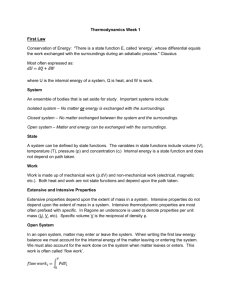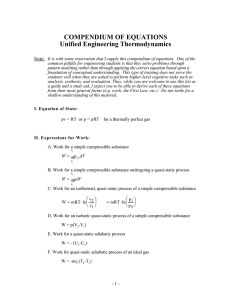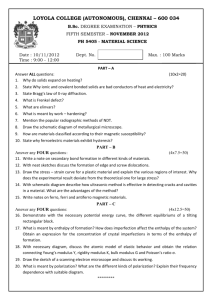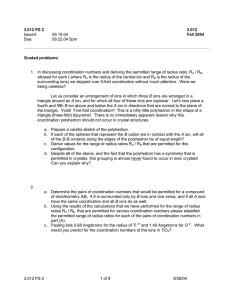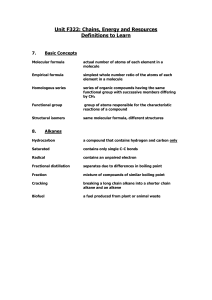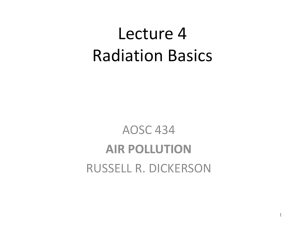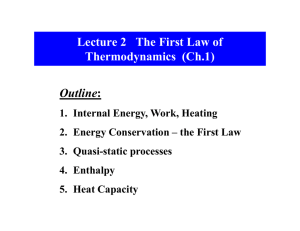Lecture Slides
advertisement
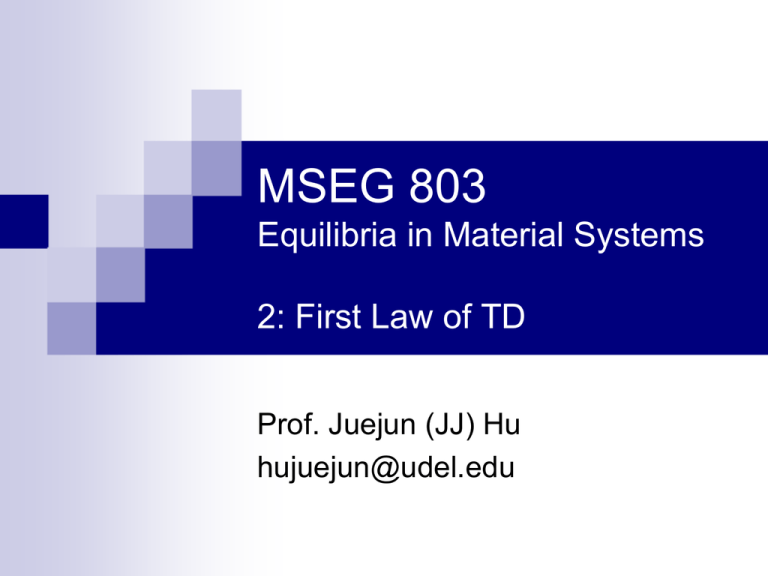
MSEG 803 Equilibria in Material Systems 2: First Law of TD Prof. Juejun (JJ) Hu hujuejun@udel.edu Early theory of heat: the caloric fluid Developed by Antoine Lavoisier in 1783 ‘The substance of heat is a subtle fluid called caloric… the quantity of this substance is constant throughout the universe, and it flows from warmer to colder bodies.’ The caloric fluid was listed as an element in the first table of elements made by Lavoisier, along with hydrogen, oxygen, sulfur, etc. and light. Rumford’s experiment Boring cannons (1798): the friction of the iron bit on the brass generated heat… LOTS of heat! ‘… the source of the heat generated by friction, in these experiments, appeared evidently to be inexhaustible.’ Heat is not a conserved quantity Heat is NOT a substance Joule experiment Enclosed by an adiabatic wall (1) Mechanical work W (2) Heat flux Q Water (system) Water (system) Enclosed by a rigid, diathermal wall Water (system) Water (system) Q and W can equivalently change the state of the system! First law of thermodynamics (the conservation of energy) The change in the internal energy of a system equals the sum of heat flux into the system and work done on the system in the process. DU = DQ + DW dU = dQ + dW = dQ - PdV dQ and dW are related to a process but not a state dQ and dW : inexact/imperfect differentials Path dependence: d x x final x initial - PdV = dW only for quasi-static processes in simple systems - dV is an exact differential but - PdV is not (Reif 2.11)! Consequence of the translational symmetry of time Ch. 21 Callen book Internal energy U Extensive state variable: path independent u = U/N : the internal energy of a system of one mole (intensive) Only relative values of U (i.e. internal energy change) matters! Forms: Kinetic energy; Potential energy (e.g. gravitational potential energy); Conservation of mechanical energy Thermal energy (atomic motion and vibration); Electric polarization energy; Magnetic polarization energy; Relativistic rest-mass energy; … Generalized “work” Change of electric polarization energy: E d p Change of magnetic polarization energy: M d H dU d Q d W d Q yi dxi i intensive extensive Different quasi-static processes Adiabatic: dQ = 0, dU = dW = - PdV Isochoric: dV = 0, dW = 0, dU = dQ Isobaric: P = constant f DW PdV P(V f Vi ) i DU DQ DW DQ ( PV f PVi ) (U f PV f ) (U i PVi ) DQ H f H i D H DQ Enthalpy: H = U + PV Also a state variable! Enthalpy change in an isobaric process is equal to heat taken in or given out from the simple system Enthalpy of phase change Vaporization Fusion/melting The difference in enthalpy per mole of molecules between the gaseous and liquid states of a substance is called the enthalpy of vaporization, DHvap The difference in enthalpy per mole of molecules between the liquid and solid states of a substance is called the enthalpy of fusion, DHfus ~ DUfus Sublimation The difference in enthalpy per mole of molecules between the gaseous and solid states of a substance is called the enthalpy of sublimation, DHsub DHsub = DHvap + DHfus Heat capacity (Molar) heat capacity C is the ratio of heat absorbed or given off (by one mole of substance) to the resulting change in temperature dQ C dT Note: C is usually not used when phase change is involved (instead DH is invoked) Heat capacity is extensive while molar heat capacity is intensive Heat capacity (cont’d) Temperature in itself does not specify the final state; generally heat capacity is defined when a second state variable (e.g. V, P) is held constant: dQ H dQ U CP ( )P ( )P CV ( )V ( )V dT T dT T For most materials, CP > CV At constant pressure, extra work is done by the system due to volume expansion V CP CV P ( )P T Material Molar heat capacity cv (J/mol K) cv/R He 12.5 1.5 Ne 12.5 1.5 Ar 12.5 1.5 H2 20.2 2.43 O2 20.2 2.43 N2 19.9 2.39 H2S 26.7 3.22 CO2 28.5 3.43 H2O (100 °C) 28.0 3.37 Arsenic 24.6 2.96 Antimony 25.2 3.03 Diamond 6.1 0.74 Copper 24.5 2.95 Silver 24.9 3.00 Mercury 28.0 3.36 H2O 75.3 9.06 Gasoline 229 27.6 Degrees of freedom Type Gases Nonmetal solids Monatomic gas 3 translational Total 3 Diatomic gas 3 translational 2 rotational Total 5 Triatomic gas Depends on molecular geometry Atomic solid 3 translational 3 vibrational Total 6 Liquid ? Metal solids Liquids The values are quoted for 25 °C and 1 atm pressure for gases unless otherwise noted Example: ideal gas Ideal gas equation: PV = NRT where N is the mole number and R = 8.31 J/(mol·K) is the ideal gas constant R = NAkB (Boltzmann constant kB = 1.38 ×1023 J/K) Internal energy: U = NcVT = cVPV/R where cV is a constant No interactions between ideal gas molecules For monatomic gas For diatomic gas cV ~ 3/2 R cV ~ 5/2 R CP CV R Clearly, U is a state variable (only depends on T)! Consider one mole of monatomic gas characterized by the equations in the last slide. 1) Calculate DU, DW and DQ when the gas quasi-statically change from state A: P = 1 atm (105 Pa), V = 22.4 L to state B: P = 0.1 atm, V = 112 L along the curves; 2) Derive the equations of isotherms and adiabats in the PV plane. A C P3V5 = constant D E B Quasi-static isothermal and adiabatic processes of ideal gas Isothermal process T = T0 (constant), PV = NRT0 U = NcVT0 (constant), i.e. dU = 0 f DW PdV i i f NRT0 Vi dV NRT0 ln( ) DQ V Vf Adiabatic process dQ = 0, dU - dW = 0 cV cV cV d ( PV ) PdV 0 ( 1) d ln V ( ) d ln P 0 R R R cV R P V cV 1 R cons tan t For monatomic gas: For diatomic gas: P3V 5 cons tan t P5V 7 cons tan t Adiabatic free expansion (non-quasi-static) Removal of constraint T, P, Vi Vacuum T, P, Vi Constraint with respect to volume Free expansion usually occurs so rapidly that heat transfer is negligible in the process: dQ = 0 Rigid walls: dW = 0 dU = 0, T = constant for ideal gas (for non-ideal gas T may change!) Different from adiabatic quasi-static expansion where dW < 0 ! Joule-Thomson (throttling) process Isenthalpic curves P1 P2 dH = 0 (i.e. U + PV = constant) in a JouleThomson process For ideal gas, dT = 0 For real gas, dT can either be greater or smaller than zero T Inversion point: 0 P H P > Pinv, J-T process leads to heating P < Pinv, J-T process leads to cooling T change? P1 Releasing gas from a compressed air cylinder P2 Gas passing through the valve: dH = 0 Gas remaining in the cylinder: dQ = 0, dW < 0, dU < 0
